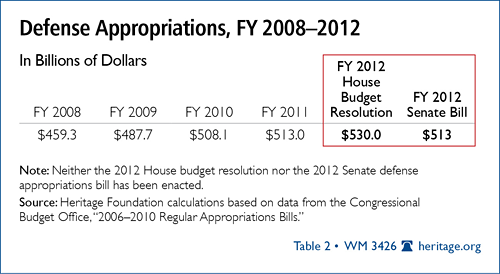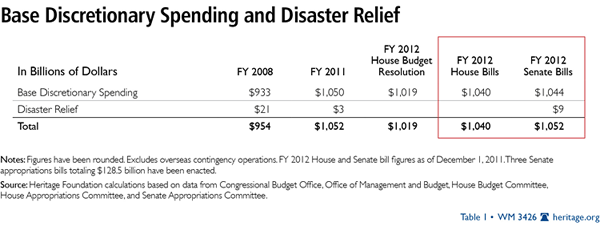With the collapse of the deficit reduction “super committee,” a year that began with promise is degenerating into another late-December budgetary scramble on Capitol Hill. Along with certain necessary decisions by Congress on tax policies, unemployment insurance, and the “doc fix,” nine of the 12 annual spending bills are still awaiting action with nearly three months of the fiscal year already passed. House and Senate appropriators plan to bundle these measures into another massive omnibus bill, an all-too-familiar practice reflecting the further breakdown of Congressional budgeting itself.
Federal spending, which reached $3.6 trillion in fiscal year (FY) 2011, continues running out of control, and deficits have now exceeded $1 trillion in each of the past three years. This chronic profligacy will drive the government’s public debt nearly to the size of the entire economy by the end of the decade. In April, the House passed a budget resolution that proposed real spending cuts, reformed major entitlement programs, reduced deficits, and stabilized the debt. Unfortunately, that resolution was largely displaced by the conclusion of the summer’s debt ceiling contest, which has yielded next to nothing.
But Congress can still recover some shreds of credibility in budgeting. If Members are willing to truly take their fiscal duties seriously, the appropriations endgame should adhere to the fundamental guidelines described below.
Five Appropriations Criteria
1. Adhere to the House Budget Levels. In addition to its bold entitlement reform proposals, the House-passed budget made strides in reducing discretionary spending. It capped non-war appropriations at $1.019 trillion for FY 2012. This was, regrettably, $86 billion above the pre-stimulus 2008 levels but about $30 billion below FY 2011 discretionary spending—a real spending cut of an appreciable amount.
House appropriators originally followed through, subdividing this amount among their 12 subcommittees.[1] The House also passed numerous appropriations bills that complied with those levels.[2] The Senate never did adopt a budget of its own, and hence no House–Senate budget agreement was reached. The House resolution, therefore, was the only real budget in town.
But after the debt ceiling agreement of August 2—the Budget Control Act (BCA), with its $1.043 trillion discretionary spending limit—House appropriators abandoned the budget and opted for the higher BCA levels, including an unnecessary $14 billion boost to the Labor–Health and Human Services–Education bill.[3]
Even worse, when final versions of the first three appropriations were agreed to in a three-bill “minibus,” the House capitulated to higher Senate spending levels for all three and also accepted additional “disaster” funding above the BCA ceilings.[4]
The flawed and loophole-riddled BCA is not a budget; it is merely a framework for ill-defined deficit reduction that offers no guidance about how to meet the government’s priorities, and it is coming unraveled anyway. The House budget is the only true and comprehensive fiscal plan to be passed by either chamber of Congress and therefore is the only budget with any claim to legitimacy. It should be adhered to. But that can happen only if the House stands its ground and insists on its appropriators’ original allocations.
2. Restore the “Regular Order.” Massive omnibus spending bills, typically rushed through the House and Senate, invite excessive spending and, because of their magnitude, leave Members far too little time to understand what they are voting on. The omnibus process concentrates decisions in a few people—the House and Senate leadership—frustrating the broad distribution of decision making that congressional committees are designed to provide.
The pileup of so many spending bills at the end of this year reflects a lack of will to budget properly. Appropriators had five months after passage of the House budget resolution in April and another four months since enactment of the BCA to complete their work. If they feel pressed for time now, they have no one to blame but themselves.
Proper budgeting requires proper procedures. Congress should restore the regular order and take up the remaining appropriations one by one. If that requires long days through the end of the session, so be it. Budgeting is still Congress’s most fundamental obligation.[5]
3. Insist on the House Defense Spending Level. Since the beginning of the Obama Administration, the Department of Defense has sustained several rounds of spending cuts[6] and faces between $445 billion and $825 billion in further reductions under the existing BCA spending caps[7]–and this is before any automatic cuts that might be required because of the super committee’s failure. These repeated defense cuts risk further jeopardizing the readiness of the U.S. military.
In this light, the $530 billion House-passed defense appropriations bill—a 3.3 percent increase in non-war spending over 2011—is the minimum Congress should provide, and it is surely preferable to the spending freeze in the Senate version of the bill.

4. Swear Off Backfilling Later. Recent press accounts[8] have indicated that Congress may resort to one of its popular tricks: under-funding defense now and then making up for it in a separate bill to fund overseas contingency operations—including funding for U.S. troops in Iraq and Afghanistan—which is not subject to the BCA limits. This is just another gimmick that allows appropriators to spend more on domestic programs and drag out uncertainty over defense spending. Congress should dismiss it out of hand and budget honestly.
5. Reject Other Gimmicks That Lead to Higher Spending. Appropriators already have begun exploiting a major loophole that exempts “disaster” funding from the $1.043 trillion BCA spending cap.[9] This gimmick could add as much as $11 billion to FY 2012 spending for responding to weather events that have already occurred, including Hurricane Katrina six years ago. Congress can and should include it within the normal spending limits.
A second subterfuge is the use of changes in mandatory program spending (CHIMPS) to hide appropriations beyond their allowed limits. The most celebrated example is the Crime Victims Trust Fund, which collects fines and penalties from convicted federal criminals and is authorized to spend all its resources. Since 2000, appropriators have been capping payouts from the fund and claiming the unspent money as “savings,” which they then use to mask higher discretionary spending.
Because this and many other CHIMPS are temporary—they apply only to the one fiscal year covered by an appropriations bill—the funding is restored in subsequent years and the savings are illusory, but the discretionary spending increases they hide are real and permanent.
The three-bill minibus passed early in November contained $9.1 billion worth of CHIMPS—$6 billion of it from the Crime Victims Trust Fund—which means discretionary spending for those measures was $9.1 billion higher than the advertised amount of $128 billion. This is another gross spending deception that should be discarded now and forever.
One Last Chance
The first session of the 112th Congress is stumbling to a close with another uncoordinated collection of presumably must-pass spending and tax bills. The faltering process, another in a series of breakdowns in congressional budgeting, will delay for at least another year any real action to correct the government’s fiscal crisis, which lies mainly in entitlement spending.
Runaway federal spending and debt are threatening the budget and the U.S. economy itself. Congress should seize every opportunity to get control of spending. With the remaining appropriations bills Congress can at least make an effort to regain some fiscal credibility. Committing to the guidelines above would show that it still takes its budgeting responsibilities seriously.
Patrick Louis Knudsen is the Grover M. Hermann Fellow in Federal Budgetary Affairs in the Thomas A. Roe Institute for Economic Policy Studies at The Heritage Foundation.



